- Home
- Agatha Christie
Poirot's Early Cases
Poirot's Early Cases Read online
Poirot’s Early
Cases
Contents
About Agatha Christie
The Agatha Christie Collection
E-book Extra
The Affair at the Victory Ball
The Adventure of the Clapham Cook
The Cornish Mystery
The Adventure of Johnnie Waverly
The Double Clue
The King of Clubs
The Lemesurier Inheritance
The Lost Mine
The Plymouth Express
The Chocolate Box
The Submarine Plans
The Third-Floor Flat
Double Sin
The Market Basing Mystery
Wasps’ Nest
The Veiled Lady
Problem at Sea
How Does Your Garden Grow?
Copyright
www.agathachristie.com
About the Publisher
About Agatha Christie
Agatha Christie is known throughout the world as the Queen of Crime. Her books have sold over a billion copies in English and another billion in 100 foreign languages. She is the most widely published author of all time and in any language, outsold only by the Bible and Shakespeare. Mrs Christie is the author of eighty crime novels and short story collections, nineteen plays, and six novels written under the name of Mary Westmacott.
Agatha Christie’s first novel, The Mysterious Affair at Styles, was written towards the end of World War I (during which she served in the Voluntary Aid Detachments). In it she created Hercule Poirot, the little Belgian investigator who was destined to become the most popular detective in crime fiction since Sherlock Holmes. After having been rejected by a number of houses, The Mysterious Affair at Styles was eventually published by The Bodley Head in 1920.
In 1926, now averaging a book a year, Agatha Christie wrote her masterpiece. The Murder of Roger Ackroyd was the first of her books to be published by William Collins and marked the beginning of an author-publisher relationship that lasted for fifty years and produced over seventy books. The Murder of Roger Ackroyd was also the first of Agatha Christie’s works to be dramatised—as Alibi—and to have a successful run in London’s West End. The Mousetrap, her most famous play, opened in 1952 and runs to this day at St Martin’s Theatre in the West End; it is the longest-running play in history.
Agatha Christie was made a Dame in 1971. She died in 1976, since when a number of her books have been published: the bestselling novel Sleeping Murder appeared in 1976, followed by An Autobiography and the short story collections Miss Marple’s Final Cases; Problem at Pollensa Bay; and While the Light Lasts. In 1998, Black Coffee was the first of her plays to be novelised by Charles Osborne, Mrs Christie’s biographer.
The Agatha Christie Collection
Christie Crime Classics
The Man in the Brown Suit
The Secret of Chimneys
The Seven Dials Mystery
The Mysterious Mr Quin
The Sittaford Mystery
The Hound of Death
The Listerdale Mystery
Why Didn’t They Ask Evans?
Parker Pyne Investigates
Murder Is Easy
And Then There Were None
Towards Zero
Death Comes as the End
Sparkling Cyanide
Crooked House
They Came to Baghdad
Destination Unknown
Spider’s Web *
The Unexpected Guest *
Ordeal by Innocence
The Pale Horse
Endless Night
Passenger To Frankfurt
Problem at Pollensa Bay
While the Light Lasts
Hercule Poirot Investigates
The Mysterious Affair at Styles
The Murder on the Links
Poirot Investigates
The Murder of Roger Ackroyd
The Big Four
The Mystery of the Blue Train
Black Coffee *
Peril at End House
Lord Edgware Dies
Murder on the Orient Express
Three-Act Tragedy
Death in the Clouds
The ABC Murders
Murder in Mesopotamia
Cards on the Table
Murder in the Mews
Dumb Witness
Death on the Nile
Appointment with Death
Hercule Poirot’s Christmas
Sad Cypress
One, Two, Buckle My Shoe
Evil Under the Sun
Five Little Pigs
The Hollow
The Labours of Hercules
Taken at the Flood
Mrs McGinty’s Dead
After the Funeral
Hickory Dickory Dock
Dead Man’s Folly
Cat Among the Pigeons
The Adventure of the Christmas Pudding
The Clocks
Third Girl
Hallowe’en Party
Elephants Can Remember
Poirot’s Early Cases
Curtain: Poirot’s Last Case
Miss Marple Mysteries
The Murder at the Vicarage
The Thirteen Problems
The Body in the Library
The Moving Finger
A Murder Is Announced
They Do It with Mirrors
A Pocket Full of Rye
4.50 from Paddington
The Mirror Crack’d from Side to Side
A Caribbean Mystery
At Bertram’s Hotel
Nemesis
Sleeping Murder
Miss Marple’s Final Cases
Tommy & Tuppence
The Secret Adversary
Partners in Crime
N or M?
By the Pricking of My Thumbs
Postern of Fate
Published as Mary Westmacott
Giant’s Bread
Unfinished Portrait
Absent in the Spring
The Rose and the Yew Tree
A Daughter’s a Daughter
The Burden
Memoirs
An Autobiography
Come, Tell Me How You Live
Play Collections
The Mousetrap and Selected Plays
Witness for the Prosecution and Selected Plays
* novelised by Charles Osborne
E-Book Extra
The Poirots
The Poirots
The Mysterious Affair at Styles; The Murder on the Links; Poirot Investigates; The Murder of Roger Ackroyd; The Big Four; The Mystery of the Blue Train; Black Coffee; Peril at End House; Lord Edgware Dies; Murder on the Orient Express; Three-Act Tragedy; Death in the Clouds; The ABC Murders; Murder in Mesopotamia; Cards on the Table; Murder in the Mews; Dumb Witness; Death on the Nile; Appointment with Death; Hercule Poirot’s Christmas; Sad Cypress; One, Two, Buckle My Shoe; Evil Under the Sun; Five Little Pigs; The Hollow; The Labours of Hercules; Taken at the Flood; Mrs McGinty’s Dead; After the Funeral; Hickory Dickory Dock; Dead Man’s Folly; Cat Among the Pigeons; The Adventure of the Christmas Pudding; The Clocks; Third Girl; Hallowe’en Party; Elephants Can Remember; Poirot’s Early Cases; Curtain: Poirot’s Last Case
1. The Mysterious Affair at Styles (1920)
Captain Arthur Hastings, invalided in the Great War, is recuperating as a guest of John Cavendish at Styles Court, the ‘country-place’ of John’s autocratic old aunt, Emily Inglethorpe—she of a sizeable fortune, and so recently remarried to a man twenty years her junior. When Emily’s sudden heart attack is found to be attributable to strychnine, Hastings recruits an old friend, now retired, to aid in the local investigation. With impeccable timi
ng, Hercule Poirot, the renowned Belgian detective, makes his dramatic entrance into the pages of crime literature.
Of note: Written in 1916, The Mysterious Affair at Styles was Agatha Christie’s first published work. Six houses rejected the novel before it was finally published—after puzzling over it for eighteen months before deciding to go ahead—by The Bodley Head.
Times Literary Supplement: ‘Almost too ingenious…very clearly and brightly told.’
2. The Murder on the Links (1923)
“For God’s sake, come!” But by the time Hercule Poirot can respond to Monsieur Renauld’s plea, the millionaire is already dead—stabbed in the back, and lying in a freshly dug grave on the golf course adjoining his estate. There is no lack of suspects: his wife, whose dagger did the deed; his embittered son; Renauld’s mistress—and each feels deserving of the dead man’s fortune. The police think they’ve found the culprit. Poirot has his doubts. And the discovery of a second, identically murdered corpse complicates matters considerably. (However, on a bright note, Captain Arthur Hastings does meet his future wife.)
The New York Times: ‘A remarkably good detective story…warmly recommended.’
Literary Review: ‘Really clever.’
Sketch: ‘Agatha Christie never lets you down.’
3. Poirot Investigates (1924)
A movie star, a diamond; a murderous ‘suicide’; a pharaoh’s curse upon his tomb; a prime minister abducted…What links these fascinating cases? The brilliant deductive powers of Hercule Poirot in…‘The Adventure of the Western Star’; ‘The Tragedy at Marsdon Manor’; ‘The Adventure of the Cheap Flat’; ‘The Mystery of the Hunter’s Lodge’; ‘The Million Dollar Bond Robbery’; ‘The Adventure of the Egyptian Tomb’; ‘The Jewel Robbery at the Grand Metropolitan’; ‘The Kidnapped Prime Minister’; ‘The Disappearance of Mr. Davenheim’; ‘The Adventure of the Italian Nobleman’; ‘The Case of the Missing Will.’
Of note: The stories collected here were first published in Sketch, beginning on March 7, 1923. Sketch also featured the first illustration of the foppish, egg-headed, elaborately moustachioed Belgian detective.
Literary Review: ‘A capital collection…ingeniously constructed and told with an engaging lightness of style.’
Irish Times: ‘In straight detective fiction there is still no one to touch [Christie].’
4. The Murder of Roger Ackroyd (1926)
In the quiet village of King’s Abbot a widow’s suicide has stirred suspicion—and dreadful gossip. There are rumours that she murdered her first husband, that she was being blackmailed, and that her secret lover was Roger Ackroyd. Then, on the verge of discovering the blackmailer’s identity, Ackroyd himself is murdered. Hercule Poirot, who has settled in King’s Abbot for some peace and quiet and a little gardening, finds himself at the centre of the case—and up against a diabolically clever and devious killer.
Of note: The Murder of Roger Ackroyd broke all the rules of detective fiction and made Agatha Christie a household name. Widely regarded as her masterpiece (though perhaps it may be called her ‘Poirot masterpiece’ since other titles in her canon—notably And Then There Were None—are similarly acclaimed), The Murder of Roger Ackroyd was the source of some controversy when it was published. The Times Literary Supplement’s praise of the first Poirot, The Mysterious Affair at Styles, ‘almost too ingenious,’ was applied by scores of readers to Ackroyd, who were nonetheless enraptured by the novel, and have remained so over the decades.
Fair warning: There are two things you must do if you know nothing of the book: discuss it with no one, and read it with all speed.
H.R.F. Keating: ‘One of the landmarks of detective literature’ (in his Crime & Mystery: The 100 Best Books).
Julian Symons: ‘The most brilliant of deceptions’ (in his Bloody Murder: From the Detective Story to the Crime Novel).
Irish Independent: ‘A classic—the book has worthily earned its fame.’
5. The Big Four (1927)
Hercule Poirot is preparing for a voyage to South America. Looming in the doorway of his bedroom is an uninvited guest, coated from head to foot in dust and mud. The man’s gaunt face registers Poirot for a moment, and then he collapses. The stranger recovers long enough to identify Poirot by name and madly and repeatedly scribble the figure ‘4’ on a piece of paper. Poirot cancels his trip. An investigation is in order. Fortunately, Poirot has the faithful Captain Hastings at his side as he plunges into a conspiracy of international scope—one that would consolidate power in the deadly cabal known as ‘The Big Four.’
6. The Mystery of the Blue Train (1928)
Le Train Bleu is an elegant, leisurely means of travel, and one certainly free of intrigue. Hercule Poirot is aboard, bound for the Riviera. And so is Ruth Kettering, the American heiress. Bailing out of a doomed marriage, she is en route to reconcile with her former lover. But her private affairs are made quite public when she is found murdered in her luxury compartment—bludgeoned almost beyond recognition. Fans of the later novel Murder on the Orient Express will not want to miss this journey by rail—and Poirot’s eerie reenactment of the crime…
7. Black Coffee (1930; 1998)
Sir Claud Amory’s formula for a powerful new explosive has been stolen, presumably by a member of his large household. Sir Claud assembles his suspects in the library and locks the door, instructing them that the when the lights go out, the formula must be replaced on the table—and no questions will be asked. But when the lights come on, Sir Claud is dead. Now Hercule Poirot, assisted by Captain Hastings and Inspector Japp, must unravel a tangle of family feuds, old flames, and suspicious foreigners to find the killer and prevent a global catastrophe.
Of note: Black Coffee was Agatha Christie’s first playscript, written in 1929. It premiered in 1930 at the Embassy Theatre in Swiss Cottage, London, before transferring the following year to St Martin’s in the West End—a theatre made famous by virtue of its becoming the permanent home of the longest-running play in history, Agatha Christie’s The Mousetrap. Agatha Christie’s biographer, Charles Osborne, who, as a young actor in 1956 had played Dr Carelli in a Tunbridge Wells production of Black Coffee, adapted the play as this novel in 1998.
Antonia Fraser, Sunday Telegraph: ‘A lively and light-hearted read which will give pleasure to all those who have long wished that there was just one more Christie to devour.’
Mathew Prichard, from his Foreword to Black Coffee: ‘This Hercule Poirot murder mystery…reads like authentic, vintage Christie. I feel sure Agatha would be proud to have written it.’
8. Peril at End House (1932)
Nick is an unusual name for a pretty young woman. And Nick Buckley has been leading an unusual life of late. First, on a treacherous Cornish hillside, the brakes on her car fail. Then, on a coastal path, a falling boulder misses her by inches. Safe in bed, she is almost crushed by a painting. Upon discovering a bullet hole in Nick’s sun hat, Hercule Poirot (who had come to Cornwall for a simple holiday with his friend Captain Hastings) decides that the girl needs his protection. At the same time, he begins to unravel the mystery of a murder that hasn’t been committed. Yet.
Times Literary Supplement: ‘Ingenious.’
9. Lord Edgware Dies (1933)
Poirot was present when the beautiful actress Jane Wilkinson bragged of her plan to ‘get rid of’ her estranged husband. Now the monstrous man is dead. But how could Jane have stabbed Lord Edgware in his library at exactly the time she was dining with friends? And what could have been her motive, since Edgware had finally granted her a divorce? The great Belgian detective, aided by Captain Hastings, can’t help feeling that some kind of heinous stagecraft is in play. And does more murder wait in the wings?
The New York Times: ‘A most ingenious crime puzzle.’
Times Literary Supplement: ‘The whole case is a triumph of Poirot’s special qualities.’
Noted crime fiction critic Julian Symons selected Lord Edgware Dies as one of Agatha Christie’s best.
10. Murder on the Orient Express (1934)
Just after midnight, a snowstorm stops the Orient Express dead in its tracks in the middle of Yugoslavia. The luxurious train is surprisingly full for this time of year. But by morning there is one passenger less. A ‘respectable American gentleman’ lies dead in his compartment, stabbed a dozen times, his door locked from the inside…Hercule Poirot is also aboard, having arrived in the nick of time to claim a second-class compartment—and the most astounding case of his illustrious career.
Regarding chronology: Agatha Christie seems not much concerned in the course of her books with their relationship to each other. It is why the Marples and the Poirots may be ready in any order, really, with pleasure. However, the dedicated Poirotist may wish to note that the great detective is returning from ‘A little affair in Syria’ at the start of Murder on the Orient Express. It is a piece of business after this ‘little affair’—the investigation into the death of an archaeologist’s wife—that is the subject of Murder in Mesopotamia (1936). If one wishes to delay a tad longer the pleasures of Orient Express, Murder in Mesopotamia offers no better opportunity.
Fair warning: Along these lines, it is advisable that one not read Cards on the Table (1936) prior to Orient Express, since Poirot himself casually gives away the ending to the latter novel.
Of note: Murder on the Orient Express is one of Agatha Christie’s most famous novels, owing no doubt to a combination of its romantic setting and the ingeniousness of its plot; its non-exploitative reference to the sensational kidnapping and murder of the infant son of Charles and Anne Morrow Lindbergh only two years prior; and a popular 1974 film adaptation, starring Albert Finney as Poirot—one of the few cinematic versions of a Christie work that met with the approval, however mild, of the author herself.

 Murder in the Mews
Murder in the Mews Postern of Fate
Postern of Fate The Regatta Mystery and Other Stories
The Regatta Mystery and Other Stories Sad Cypress
Sad Cypress Why Didn't They Ask Evans?
Why Didn't They Ask Evans? After the Funeral
After the Funeral And Then There Were None
And Then There Were None The Witness for the Prosecution
The Witness for the Prosecution Murder on the Orient Express
Murder on the Orient Express The Seven Dials Mystery
The Seven Dials Mystery Hercule Poirot: The Complete Short Stories
Hercule Poirot: The Complete Short Stories The Mysterious Affair at Styles
The Mysterious Affair at Styles Sleeping Murder
Sleeping Murder Hickory Dickory Dock
Hickory Dickory Dock The Moving Finger
The Moving Finger The Mirror Crack'd From Side to Side
The Mirror Crack'd From Side to Side Ordeal by Innocence
Ordeal by Innocence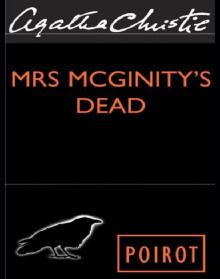 Mrs. McGinty's Dead
Mrs. McGinty's Dead Problem at Pollensa Bay and Other Stories
Problem at Pollensa Bay and Other Stories Death Comes as the End
Death Comes as the End Endless Night
Endless Night Parker Pyne Investigates
Parker Pyne Investigates Poirot's Early Cases: 18 Hercule Poirot Mysteries
Poirot's Early Cases: 18 Hercule Poirot Mysteries Murder Is Easy
Murder Is Easy An Autobiography
An Autobiography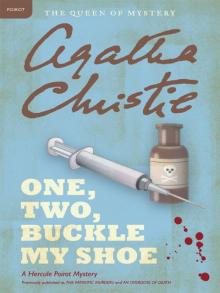 One, Two, Buckle My Shoe
One, Two, Buckle My Shoe A Pocket Full of Rye
A Pocket Full of Rye The Mysterious Mr. Quin
The Mysterious Mr. Quin The Mystery of the Blue Train
The Mystery of the Blue Train Hercule Poirot's Christmas: A Hercule Poirot Mystery
Hercule Poirot's Christmas: A Hercule Poirot Mystery Cards on the Table (SB)
Cards on the Table (SB) Three Act Tragedy
Three Act Tragedy The Secret Adversary
The Secret Adversary The Body in the Library
The Body in the Library The Pale Horse
The Pale Horse While the Light Lasts
While the Light Lasts The Golden Ball and Other Stories
The Golden Ball and Other Stories Double Sin and Other Stories
Double Sin and Other Stories The Secret of Chimneys
The Secret of Chimneys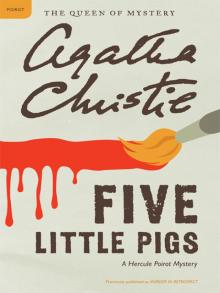 Five Little Pigs
Five Little Pigs Murder in Mesopotamia: A Hercule Poirot Mystery
Murder in Mesopotamia: A Hercule Poirot Mystery The Mousetrap and Other Plays
The Mousetrap and Other Plays Lord Edgware Dies
Lord Edgware Dies The Hound of Death
The Hound of Death The Murder on the Links
The Murder on the Links A Caribbean Mystery
A Caribbean Mystery Peril at End House: A Hercule Poirot Mystery
Peril at End House: A Hercule Poirot Mystery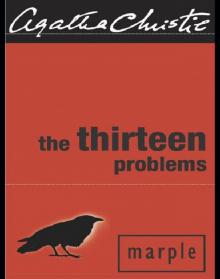 The Thirteen Problems
The Thirteen Problems By the Pricking of My Thumbs
By the Pricking of My Thumbs Mrs McGinty's Dead / the Labours of Hercules (Agatha Christie Collected Works)
Mrs McGinty's Dead / the Labours of Hercules (Agatha Christie Collected Works) Appointment With Death
Appointment With Death Murder Is Announced
Murder Is Announced The Big Four
The Big Four Three Blind Mice and Other Stories
Three Blind Mice and Other Stories Hercule Poirot- the Complete Short Stories
Hercule Poirot- the Complete Short Stories Passenger to Frankfurt
Passenger to Frankfurt They Do It With Mirrors
They Do It With Mirrors Poirot Investigates
Poirot Investigates The Coming of Mr. Quin: A Short Story
The Coming of Mr. Quin: A Short Story 4:50 From Paddington
4:50 From Paddington The Last Seance
The Last Seance Dead Man's Folly
Dead Man's Folly The Adventure of the Christmas Pudding
The Adventure of the Christmas Pudding The A.B.C. Murders
The A.B.C. Murders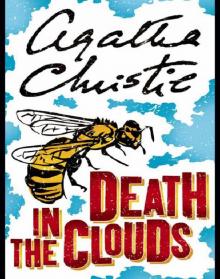 Death in the Clouds
Death in the Clouds Towards Zero
Towards Zero The Listerdale Mystery and Eleven Other Stories
The Listerdale Mystery and Eleven Other Stories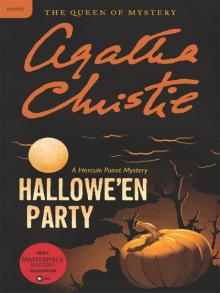 Hallowe'en Party
Hallowe'en Party Murder at the Vicarage
Murder at the Vicarage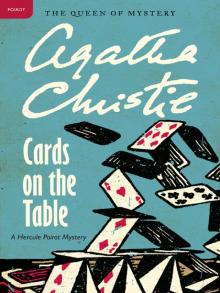 Cards on the Table
Cards on the Table Death on the Nile
Death on the Nile Curtain
Curtain Partners in Crime
Partners in Crime The Listerdale Mystery / the Clocks (Agatha Christie Collected Works)
The Listerdale Mystery / the Clocks (Agatha Christie Collected Works) Taken at the Flood
Taken at the Flood Dumb Witness
Dumb Witness The Complete Tommy and Tuppence
The Complete Tommy and Tuppence Problem at Pollensa Bay
Problem at Pollensa Bay Cat Among the Pigeons
Cat Among the Pigeons At Bertram's Hotel
At Bertram's Hotel Nemesis
Nemesis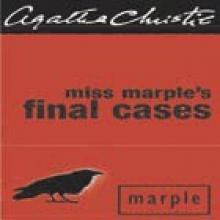 Miss Marple's Final Cases
Miss Marple's Final Cases The Hollow
The Hollow Midwinter Murder
Midwinter Murder They Came to Baghdad
They Came to Baghdad Third Girl
Third Girl Destination Unknown
Destination Unknown Hercule Poirot and the Greenshore Folly
Hercule Poirot and the Greenshore Folly Postern of Fate tat-5
Postern of Fate tat-5 Midsummer Mysteries
Midsummer Mysteries Poirot's Early Cases hp-38
Poirot's Early Cases hp-38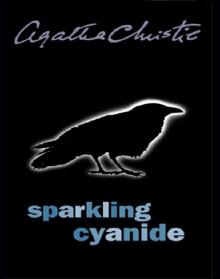 Sparkling Cyanide
Sparkling Cyanide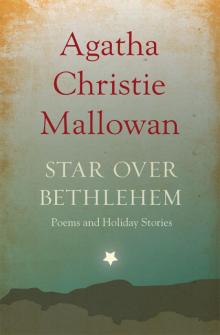 Star over Bethlehem
Star over Bethlehem Black Coffee hp-7
Black Coffee hp-7 Hercule Poirot's Casebook (hercule poirot)
Hercule Poirot's Casebook (hercule poirot) Murder in Mesopotamia hp-14
Murder in Mesopotamia hp-14 A Pocket Full of Rye: A Miss Marple Mystery (Miss Marple Mysteries)
A Pocket Full of Rye: A Miss Marple Mystery (Miss Marple Mysteries) The Listerdale Mystery
The Listerdale Mystery The Complete Tommy & Tuppence Collection
The Complete Tommy & Tuppence Collection Lord Edgware Dies hp-8
Lord Edgware Dies hp-8 Death in the Clouds hp-12
Death in the Clouds hp-12 Short Stories
Short Stories Third Girl hp-37
Third Girl hp-37 Why Didn't They Ask Evans
Why Didn't They Ask Evans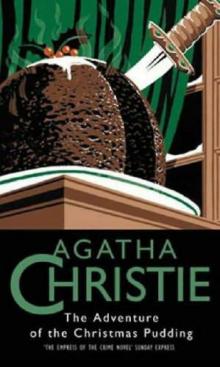 Adventure of the Christmas Pudding and other stories
Adventure of the Christmas Pudding and other stories Cards on the Table hp-15
Cards on the Table hp-15 The Mystery of the Blue Train hp-6
The Mystery of the Blue Train hp-6 After the Funeral hp-29
After the Funeral hp-29 Poirot Investigates hp-3
Poirot Investigates hp-3 Murder on the Links hp-2
Murder on the Links hp-2 The Mysterious Mr Quin
The Mysterious Mr Quin Curtain hp-39
Curtain hp-39 Hercule Poirot's Christmas hp-19
Hercule Poirot's Christmas hp-19 Partners in Crime tat-2
Partners in Crime tat-2 The Clocks hp-36
The Clocks hp-36 Murder, She Said
Murder, She Said The Clocks
The Clocks The Hollow hp-24
The Hollow hp-24 Appointment with Death hp-21
Appointment with Death hp-21 Murder in the mews hp-18
Murder in the mews hp-18 The Murder Of Roger Ackroyd hp-4
The Murder Of Roger Ackroyd hp-4 Dumb Witness hp-16
Dumb Witness hp-16 The Sittaford Mystery
The Sittaford Mystery Mrs McGinty's Dead
Mrs McGinty's Dead Evil Under the Sun
Evil Under the Sun The A.B.C. Murders hp-12
The A.B.C. Murders hp-12 The Murder at the Vicarage mm-1
The Murder at the Vicarage mm-1 The Body in the Library mm-3
The Body in the Library mm-3 Miss Marple and Mystery
Miss Marple and Mystery Sleeping Murder mm-14
Sleeping Murder mm-14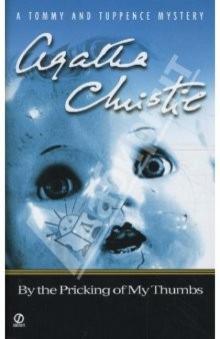 By the Pricking of My Thumbs tat-4
By the Pricking of My Thumbs tat-4 A Pocket Full of Rye mm-7
A Pocket Full of Rye mm-7 Hickory Dickory Dock: A Hercule Poirot Mystery
Hickory Dickory Dock: A Hercule Poirot Mystery The Big Four hp-5
The Big Four hp-5 The Labours of Hercules hp-26
The Labours of Hercules hp-26 The Complete Miss Marple Collection
The Complete Miss Marple Collection The Labours of Hercules
The Labours of Hercules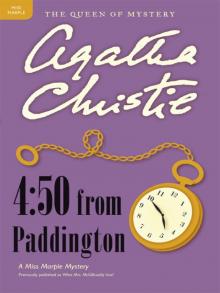 4.50 From Paddington
4.50 From Paddington A Murder Is Announced mm-5
A Murder Is Announced mm-5 Agahta Christie: An autobiography
Agahta Christie: An autobiography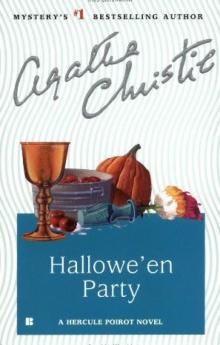 Hallowe'en Party hp-36
Hallowe'en Party hp-36 Black Coffee
Black Coffee The Mysterious Affair at Styles hp-1
The Mysterious Affair at Styles hp-1 Three-Act Tragedy
Three-Act Tragedy Best detective short stories
Best detective short stories Three Blind Mice
Three Blind Mice Nemesis mm-11
Nemesis mm-11 The Mirror Crack'd from Side to Side mm-8
The Mirror Crack'd from Side to Side mm-8 The ABC Murders
The ABC Murders Poirot's Early Cases
Poirot's Early Cases The Unexpected Guest
The Unexpected Guest A Caribbean Mystery - Miss Marple 09
A Caribbean Mystery - Miss Marple 09 The Murder of Roger Ackroyd
The Murder of Roger Ackroyd Elephants Can Remember hp-39
Elephants Can Remember hp-39 The Mirror Crack'd: from Side to Side
The Mirror Crack'd: from Side to Side Sad Cypress hp-21
Sad Cypress hp-21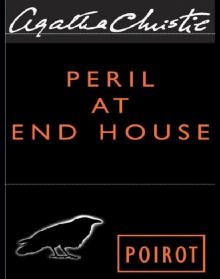 Peril at End House
Peril at End House Elephants Can Remember
Elephants Can Remember Best detective stories of Agatha Christie
Best detective stories of Agatha Christie Hercule Poirot's Christmas
Hercule Poirot's Christmas The Body In The Library - Miss Marple 02
The Body In The Library - Miss Marple 02 Evil Under the Sun hp-25
Evil Under the Sun hp-25 The Capture of Cerberus
The Capture of Cerberus The Hound of Death and Other Stories
The Hound of Death and Other Stories The Thirteen Problems (miss marple)
The Thirteen Problems (miss marple) The Thirteen Problems-The Tuesday Night Club
The Thirteen Problems-The Tuesday Night Club Spider's Web
Spider's Web At Bertram's Hotel mm-12
At Bertram's Hotel mm-12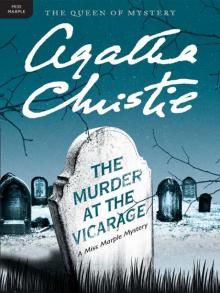 The Murder at the Vicarage (Agatha Christie Mysteries Collection)
The Murder at the Vicarage (Agatha Christie Mysteries Collection) A Caribbean Mystery (miss marple)
A Caribbean Mystery (miss marple) A Murder Is Announced
A Murder Is Announced Clues to Christie
Clues to Christie The Moving Finger mm-3
The Moving Finger mm-3 The Harlequin Tea Set and Other Stories
The Harlequin Tea Set and Other Stories Murder on the Links
Murder on the Links The Murder at the Vicarage
The Murder at the Vicarage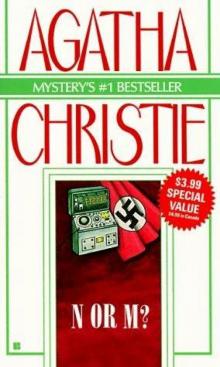 N or M tat-3
N or M tat-3 The Secret Adversary tat-1
The Secret Adversary tat-1 The Burden
The Burden Mrs McGinty's Dead hp-28
Mrs McGinty's Dead hp-28 Dead Man's Folly hp-31
Dead Man's Folly hp-31 Peril at End House hp-8
Peril at End House hp-8 Complete Short Stories Of Miss Marple mm-16
Complete Short Stories Of Miss Marple mm-16 Curtain: Poirot's Last Case
Curtain: Poirot's Last Case The Man in the Brown Suit
The Man in the Brown Suit They Do It With Mirrors mm-6
They Do It With Mirrors mm-6